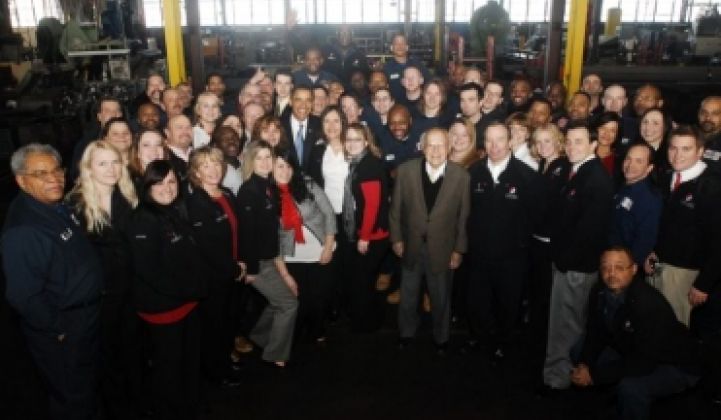It might surprise the futurists and environmental activists who support renewable energy to find out that the renewable manufacturing industries, according to a number of studies, create as many -- if not more -- blue-collar, boots-on-the-ground jobs as the fossil fuels industry. In 2009, the number of wind industry workers -- many in manufacturing, heavy transport and factory assembly -- surpassed the total number of workers in coal mining for the first time.
At a recent press conference, the American Wind Energy Association (AWEA) joined with leaders from the United Steelworkers and members of the BlueGreen Alliance to announce the release of Winds Of Change, a new report that describes the 18,500 manufacturing jobs now provided by the wind energy industry and the seven times as many manufacturing jobs that could materialize in the next five years from a wind industry supported by policies such as a Renewable Electricity Standard (RES) requiring regulated U.S. utilities to obtain 25 percent of their power from renewable sources by 2025.
"The expansion of the wind industry, if we do it right, has the ability to revitalize American manufacturing," said Jason Walsh, the Director of Policy for the BlueGreen Alliance, a coalition of labor unions, including the United Steelworkers, and environmental groups, like the Sierra Club.
"A typical wind turbine has 8,000 component parts and 250 tons of steel," Walsh said. "It won't be a handful of scientists and engineers who build this green economy," Walsh said. "It's going to be pipefitters and machinists and technicians and welders. These are good, middle-class jobs -- you can call them blue-collar jobs -- that have been transformed into green-collar jobs. And, very importantly, they are accessible to a very broad range of workers as long as they get the right training and the right support."
A turbine tower is made from 100 tons of steel. Factory-made fiberglass blades and the steel rotor that turns them can weigh 40 tons. The fiberglass nacelle, a turbine's brain and heart containing the gearing, generator, and thousands of those component parts, can weigh 70 tons.
Three years ago, John Grabner, the President of Cardinal Fastener, grabbed a chance to supply wind turbine fasteners to a project developer when European fasteners proved unsatisfactory. Because the work was profitable for Cardinal, Grabner went after more. With wind's record 2009 installations, Cardinal grew its manufacturing jobs 67 percent last year. The photo accompanying this post was taken at Cardinal. Can you spot the leader of the free world in there?
"The wind industry is real," Grabner said, "and the turbine manufacturers are doing what they said they would do. They are homologating their supply chain." (Homologation is the entirely legal marriage of foreign turbine technology and domestically manufactured components. Walsh called it "insourcing.")
"When we talk about green jobs," Walsh said, "there's often a misconception about what these jobs are. These are not jobs that are somewhere out there in the sci-fi future. They are jobs that already exist but are geared toward green ends."
There are three basic reasons that Vestas, the world's largest manufacturer of turbines, wants to buy U.S.-made parts, Grabner said. They want to deal in dollars, they save 18 percent to 20 percent on transportation costs, and they want to build a domestic manufacturing base so the federal government will continue to support the renewables industries.
"It's like a ripple effect," Grabner said, explaining why he accepts the independent studies that show a national Renewable Electricity Standard (RES) will create 274,000 jobs.
"When we get an order for fasteners for a wind turbine, we call the steel mill, who gets hold of the iron ore mine. They do their job with the steel and send it to us via truck. We build it and send it to our outside service folks, who in turn heat, treat and plate it," Grabner explained. "Then it goes to the turbine manufacturer and then into the field."
That is the ripple effect for just one critical component used to attach tower segments, attach the nacelle to the tower, and attach the blades to the hub. As Walsh pointed out, a wind turbine has over 8,000 such components.
Once manufactured, parts are sent to assembly centers. Once assembled, the tower and nacelle must be transported to the installation site. Grabner said Cardinal regularly ships tons of fasteners via trucking companies. Walsh pointed out that towers and nacelles are often transported by rail. Blades are usually trucked. Such transport puts the domestic rail and trucking labor force to work.
At the installation site, it's a matter of boots on the ground. "Installing these turbines is a large construction project," Walsh said. "It's good for the economy."
Once the wind installation is producing electricity, operations personnel and maintenance workers must be onsite regularly, booting it up the towers to monitor and service gearboxes and generators.
"Building a green economy will involve some brand-new industries and jobs but, for the most part, it will involve transforming the industries and jobs we already have," Walsh said. A welder who once worked on submarines can become a welder of wind turbine towers. "Same skill set," Walsh said. "Very different economic ends."
"The culture in the manufacturing base has got to change," John Grabner said. "There is an opportunity there, but you've got to be in the right place at the right time with the right attitude to get it."



